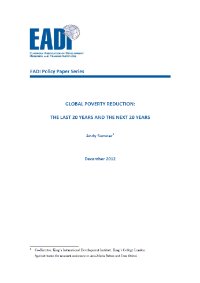Global Poverty Reduction: The Last 20 Years and the Next 20 Years

POLICY PAPER by Andy Sumner, King's College London
Over time global poverty is increasingly becoming a matter of domestic inequality because the majority of the world's poor by income and multi-dimensional poverty measures now live in countries categorized by the World Bank as middle-income countries.
This 'geography of poverty' raises questions about the usefulness of country classifications and about the types of economic growth that leads some countries to reduce the number of people in extreme poverty and other countries not to. Although the thresholds do not mean a sudden change in countries when a line is crossed in per capita income, substantially higher levels of average per capita income imply substantially more domestic resources available for poverty reduction and – most importantly for donors – the current aid system does treat countries differently if they are LICs or MICs.
Visit EADI to read the paper in full






